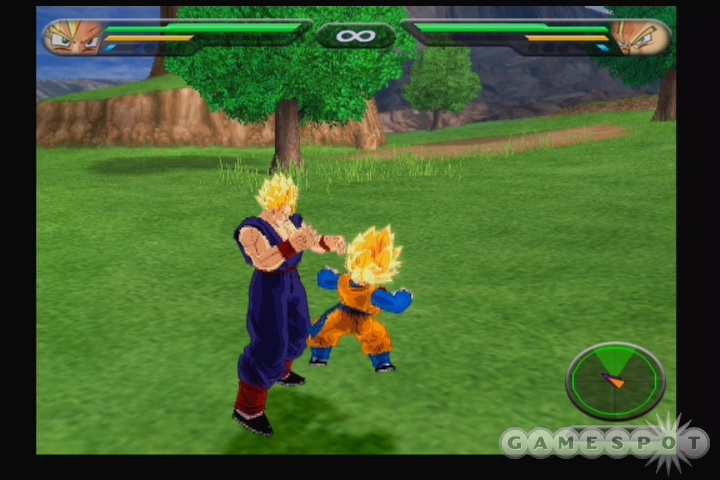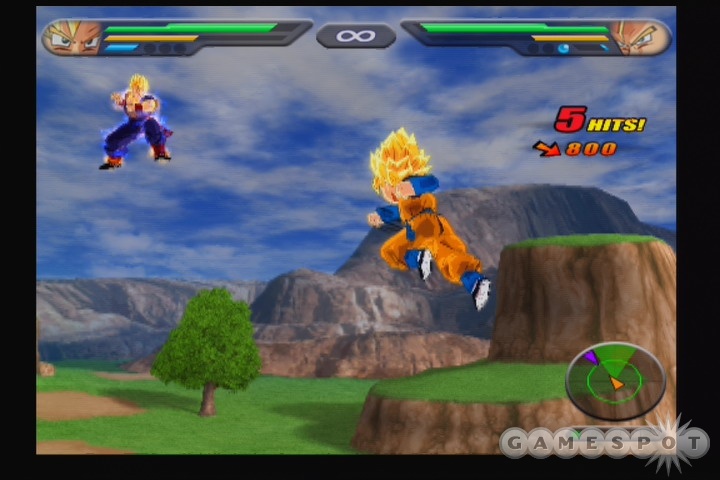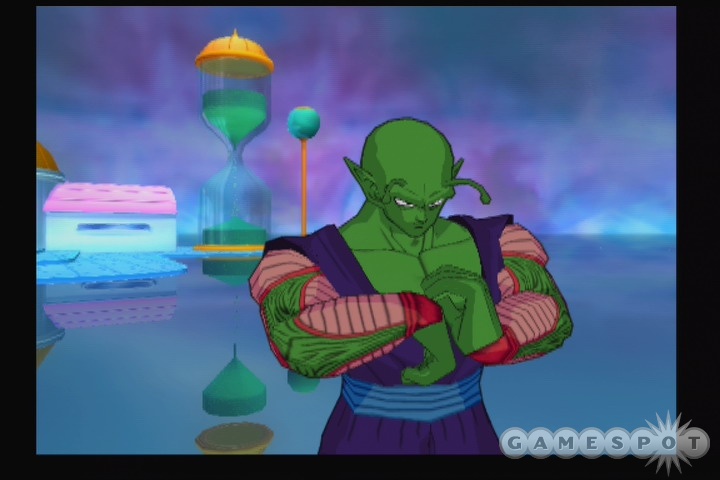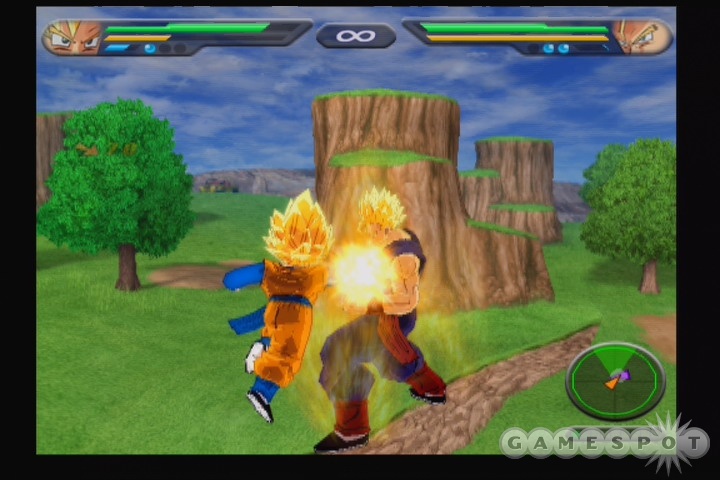Dragon Ball Z: Budokai Tenkaichi Feature Preview
We get an exclusive look at the latest entry in Atari's winning Dragon Ball Z fighting series.
It's safe to say that, as of late, the cult anime megahit Dragon Ball Z has managed to find its stride in the world of video games. The decades-old anime juggernaut has managed to finally find the right balance between fan service and standard game conventions with the Dragon Ball Z: Budokai series from Atari. The 3D fighters have packed solid gameplay with slick art and a generous helping of familiar faces from the venerable series. The latest entry in the series, Dragon Ball Z: Budokai Tenkaichi for the PlayStation 2, aims to be the biggest yet, with a mob of playable characters, bigger environments to accommodate the over-the-top battles (which can rage across land, sea, and air), and a new look that brings the game even closer to its animation roots. We had the chance to get our hands on a work-in-progress PlayStation 2 version of the game for an exclusive look to see if it's living up to the promise of its predecessors.

For the fourth entry in the series, Atari worked with Japanese developer Spike, as opposed to longtime studio Dimps, which has handled the development chores on the Budokai series since its 2002 debut. As a result, you can expect a fresh take on the series that sticks with what worked in Budokai 3, but adds some new material to boot. Though this may make you wonder if the change in developer has broken anything key in the series, know that though there have been some changes, the game doesn't appear to be heading down the path of sequels that go horribly wrong once they change developers. However, it's not an entirely smooth ride, either.
You'll find seven modes in the game: five gameplay and two extra. The gameplay modes are Z battle gate, ultimate battle, world tournament, dueling, and practice. The two extra modes are evolution Z and a character-illustration mode that lets you view character art from the game. Z battle gate is the most significant addition to the DBZ experience in Tenkaichi. The new mode is a greatest-hits-style collection of key story arcs and their ensuing battles from the series. You'll be able to engage in more than 100 different story-based battles that cast you as all the major players from the series. The mode will start with only a handful of the battles available, leaving you the challenge of unlocking the rest. The battles are quick, satisfying bouts that have various requirements for victory, such as surviving a set amount of time, finishing off your opponent with a super move, or simply defeating him or her in combat. Each match is preceded by a dramatic cinematic that sets the scene and brings you up to speed on where the story is at the time of your fight.
Ultimate battle is a hardcore championship that pits you against a series of 100 fighters and requires you to crawl your way up to the top of the heap. The twist is that you'll start out with 10 measly points that you'll have to grow to climb the ranks. While winning battles will earn you a single point, the good stuff comes from meeting the various bonus-point requirements, such as ending a match with a super move or winning in under a minute. As you earn points you'll go up in rank and face off against more fighters--until you've climbed the heap of 100, which is quite an accomplishment. You're helped out a bit by being able to customize your fighter using the various capsules you'll earn across the different modes. But either way, you should plan on a whole lot of work.
Meanwhile, world tournament is the basic series of unlockable tournaments you've seen in the previous games. You'll start out with a novice tournament, and you'll unlock additional difficulties as you win them. Dueling is your good old-fashioned versus mode that lets you face off against a friend. As before, you or a friend can bring your customized fighter over on a memory card so you can throw down to see who has the better customized brawler. Finally, practice lets you hone your skills against artificial-intelligence opponents you can customize to give yourself a healthy workout.
The two non-gameplay modes have ties to the five main modes based on content that will unlock as you play. Evolution Z lets you customize fighters with capsules that you'll collect as you complete matches. The various capsules offer all manner of upgrades, such as increased attack or defense, new special attacks, or passive bonuses (such as health regeneration). The more you play, the more capsules you'll earn, which translates into more customization options.

Control in the game remains true to the basic four-button mechanic last seen in Budokai 3. Melee, ki blast, dash, and block are assigned to the Dual Shock's face buttons. The shoulder buttons let you control your flight, charge your ki, and pull off each fighter's devastating super moves. The setup works as well as it always has, offering a good pick-up-and-play experience with a small helping of depth to keep it interesting.
Getting Combative
But while the game's control is pretty much identical to the preview entries in the series, the combat system isn't. Spike has gone ahead and made some changes to the combat mechanics that will require veteran Budokai players to adjust their strategies. The most significant change to the system is tied to the new camera, which brings your view in very tightly on your fighter. As a result, your view is different from the traditional 2D-esque side view the Budokai games drew on from such traditional fighters as Tekken and Virtua Fighter. This will require a bit of adjustment on players' parts as they get comfortable with moving in and out of the screen and toward their opponents by pushing up and down on the D pad. The other key element tweaked in the game involves the implementation of super moves, which are now triggered by various shoulder-button, D-pad, and ki-button combinations. The system works pretty well, as it keeps the pace of the fights going at a good clip. However, you'll need to be careful managing the attacks with the new camera system. All told, we're not totally sold on the new feel and pacing, but we're withholding judgment until we see the final game.

The visuals are arguably the best seen in the series to date, and they raise the bar of quality up several notches. The cel-shaded look that's been evolving since the first game has been refined quite a bit for Tenkaichi and is the closest the series has ever come to replicating the impressive look Akira Toriyama crafted for the anime. The centerpiece of the visuals is obviously the cast of fighters, whose members look spot-on to their animated counterparts. However, special effects run a close second, as each character's unique attacks are bound pretty tightly to his or her appearance in the game, and they are re-created in exact detail. Savvy use of black lines on the polygon models and animations for the special attacks do an impressive job of capturing the look of the 'toon. The environments are almost as successful, but based on the build we played, they still need to tighten up some. To the game's credit, the environments have been significantly bulked up from the previous entries and offer a much larger, interactive space for you to duke it out. The arenas feature a grand sense of scale and fully support the hectic madness of a raging battle between superbeings that finds them knocking each other through mountains or into the depths of the ocean. The only element that falls a bit short right now is their overall look, which lacks some of the flair that makes the characters and effects so perfect. Despite this one minor element, the visuals are an impressive showcase for the graphics engine, which supports all of the above with a smooth and high frame rate that's been pretty consistent in our version of the game.
As far as sound goes, much like in the previous entries in the Budokai series, DBZ: Budokai Tenkaichi features spot-on audio thanks to liberal usage of music, effects, and voice actors taken straight from the anime. The music mixes familiar themes during the menu screens with authentic tunes that play during combat, which match the fighting arenas. The familiar effects for the gang's assortment of powers and supers are all on hand to get fans to jump in the right spots during battle. Finally, the game's voice cast, arguably one of the linchpins of the franchise's appeal and authenticity, is working overtime in Tenkaichi. The massive cast of playable characters is voiced by its appropriate US voice actors, which is an appreciated nod to fans of the series. Even if you aren't a diehard DBZ fan, you'd be hard-pressed to not be pleased by Tenkaichi's audio offerings.

Based on what we've played, Dragon Ball Z: Budokai Tenkaichi is a promising sequel to last year's excellent fighter. The sheer volume of content being crammed in to the game is impressive, and the visuals are outstanding. We're not totally fine with the way the new camera has changed the flow of battles, which we expect may give some fans trouble, and we're hoping combat feels a little tighter when the game wraps up. Still, we'd like to think that things will work out, particularly given how well the series has been going. Just know that if you go in expecting the same fighting experience as in Budokai 3, you're going to get taken to school. Dragon Ball Z: Budokai Tenkaichi is currently slated to ship this fall for the PlayStation 2, so look for our full review soon.
Got a news tip or want to contact us directly? Email news@gamespot.com
Join the conversation